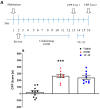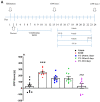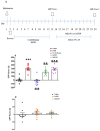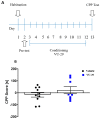Effects of the Positive Allosteric Modulator of Metabotropic Glutamate Receptor 5, VU-29, on Maintenance Association between Environmental Cues and Rewarding Properties of Ethanol in Rats
- PMID: 32443872
- PMCID: PMC7277181
- DOI: 10.3390/biom10050793
Effects of the Positive Allosteric Modulator of Metabotropic Glutamate Receptor 5, VU-29, on Maintenance Association between Environmental Cues and Rewarding Properties of Ethanol in Rats
Abstract
: Metabotropic glutamate subtype 5 (mGlu5) receptors are implicated in various forms of synaptic plasticity, including drugs of abuse. In drug-addicted individuals, associative memories can drive relapse to drug use. The present study investigated the potential of the mGlu5 receptor positive allosteric modulator (PAM), VU-29 (30 mg/kg, i.p.), to inhibit the maintenance of a learned association between ethanol and environmental context by using conditioned place preference (CPP) in rats. The ethanol-CPP was established by the administration of ethanol (1.0 g/kg, i.p. × 10 days) using an unbiased procedure. Following ethanol conditioning, VU-29 was administered at various post-conditioning times (ethanol free state at the home cage) to ascertain if there was a temporal window during which VU-29 would be effective. Our experiments indicated that VU-29 did not affect the expression of ethanol-induced CPP when it was given over two post-conditioning days. However, the expression of ethanol-CPP was inhibited by 10-day home cage administration of VU-29, but not by first 2-day or last 2-day injection of VU-29 during the 10-day period. These findings reveal that VU-29 can inhibit the maintenance of ethanol-induced CPP, and that treatment duration contributes to this effect of VU-29. Furthermore, VU-29 effect was reversed by pretreatment with either MTEP (the mGlu5 receptor antagonist), or MK-801 (the N-methyl-D-aspartate-NMDA receptor antagonist). Thus, the inhibitory effect of VU-29 is dependent on the functional interaction between mGlu5 and NMDA receptors. Because a reduction in ethanol-associated cues can reduce relapse, mGlu5 receptor PAM would be useful for therapy of alcoholism. Future research is required to confirm the current findings.
Keywords: VU-29; conditioned place preference; ethanol; mGlu5 receptor; memory; positive allosteric modulator; reward.
Conflict of interest statement
The authors declare no conflict of interest.
Figures




Similar articles
-
Effects of the Positive Allosteric Modulator of Metabotropic Glutamate Receptor 5, VU-29, on Impairment of Novel Object Recognition Induced by Acute Ethanol and Ethanol Withdrawal in Rats.Neurotox Res. 2018 Apr;33(3):607-620. doi: 10.1007/s12640-017-9857-z. Epub 2018 Jan 2. Neurotox Res. 2018. PMID: 29294238 Free PMC article.
-
ADX-47273, a mGlu5 receptor positive allosteric modulator, attenuates deficits in cognitive flexibility induced by withdrawal from 'binge-like' ethanol exposure in rats.Behav Brain Res. 2018 Feb 15;338:9-16. doi: 10.1016/j.bbr.2017.10.007. Epub 2017 Oct 10. Behav Brain Res. 2018. PMID: 29030082
-
Involvement of metabotropic glutamate receptor 5 in the inhibition of methamphetamine-associated contextual memory after prolonged extinction training.J Neurochem. 2016 Apr;137(2):216-25. doi: 10.1111/jnc.13525. Epub 2016 Jan 24. J Neurochem. 2016. PMID: 26748780
-
Alcohol Addiction- Metabotropic Glutamate Receptor Subtype 5 and its Ligands: How They All Come Together?Curr Drug Targets. 2018;19(8):907-915. doi: 10.2174/1389450118666170511144302. Curr Drug Targets. 2018. PMID: 28494749 Review.
-
SAR studies on mGlu5 receptor positive allosteric modulators (2003- 2013).Curr Top Med Chem. 2014;14(15):1789-841. doi: 10.2174/1568026614666140826120419. Curr Top Med Chem. 2014. PMID: 25176124 Review.
Cited by
-
Neonatal Maternal Separation Induces Sexual Dimorphism in Brain Development: The Influence on Amino Acid Levels and Cognitive Disorders.Biomolecules. 2023 Sep 26;13(10):1449. doi: 10.3390/biom13101449. Biomolecules. 2023. PMID: 37892131 Free PMC article.
-
Effects of positive mGlu5 modulation on D2 signaling and nicotine-conditioned place preference: Mechanisms of epigenetic inheritance in a transgenerational model of drug abuse vulnerability in psychosis.J Psychopharmacol. 2025 Mar;39(3):265-281. doi: 10.1177/02698811241292902. Epub 2024 Oct 27. J Psychopharmacol. 2025. PMID: 39462877 Free PMC article.
-
Modulation of mGlu5 reduces rewarding associative properties of nicotine via changes in mesolimbic plasticity: Relevance to comorbid cigarette smoking in psychosis.Pharmacol Biochem Behav. 2024 Jun;239:173752. doi: 10.1016/j.pbb.2024.173752. Epub 2024 Mar 21. Pharmacol Biochem Behav. 2024. PMID: 38521210 Free PMC article.
-
Memantine Prevents the WIN 55,212-2 Evoked Cross-Priming of Ethanol-Induced Conditioned Place Preference (CPP).Int J Mol Sci. 2021 Jul 26;22(15):7940. doi: 10.3390/ijms22157940. Int J Mol Sci. 2021. PMID: 34360704 Free PMC article.
References
-
- Niaura R.S., Rohsenow D.J., Binkoff J.A., Monti P.M., Pedraza M., Abrams D.B. Relevance of cue reactivity to understanding alcohol and smoking relapse. J. Abnorm. Psychol. 1988;97:133–152. - PubMed
Publication types
MeSH terms
Substances
Grants and funding
LinkOut - more resources
Full Text Sources
Medical
Miscellaneous

